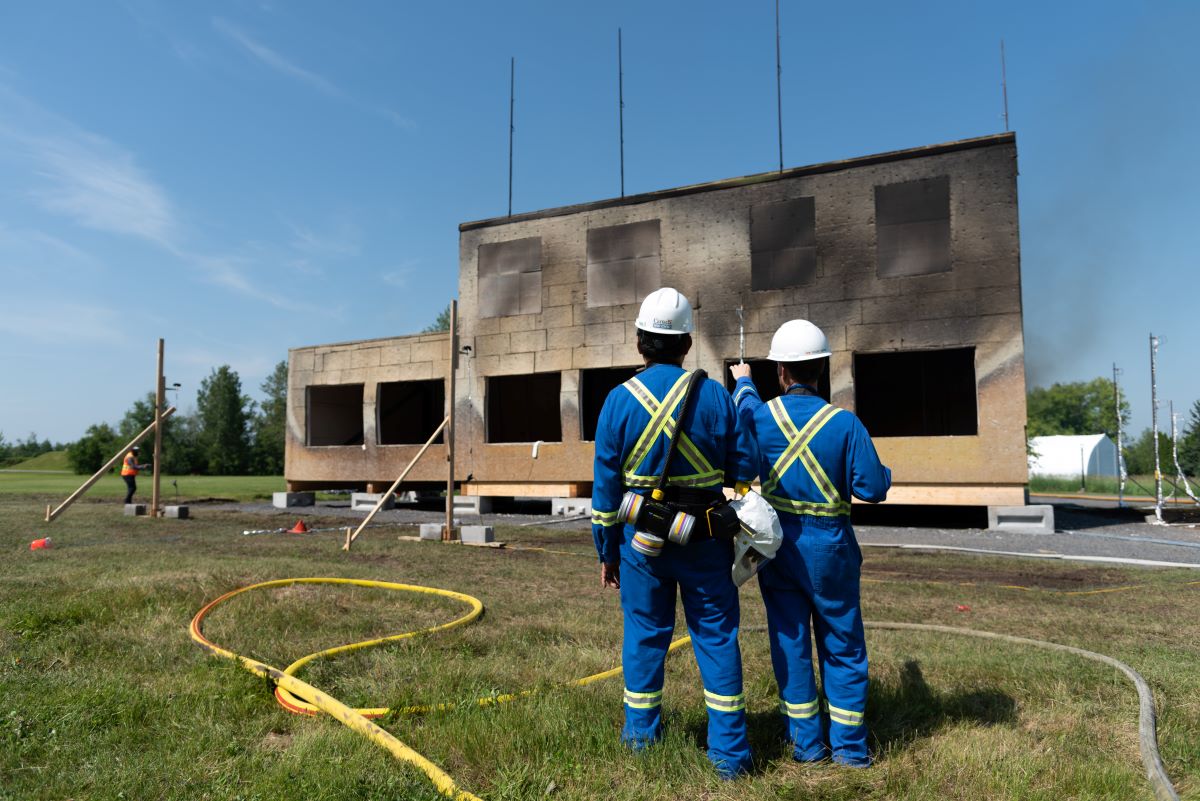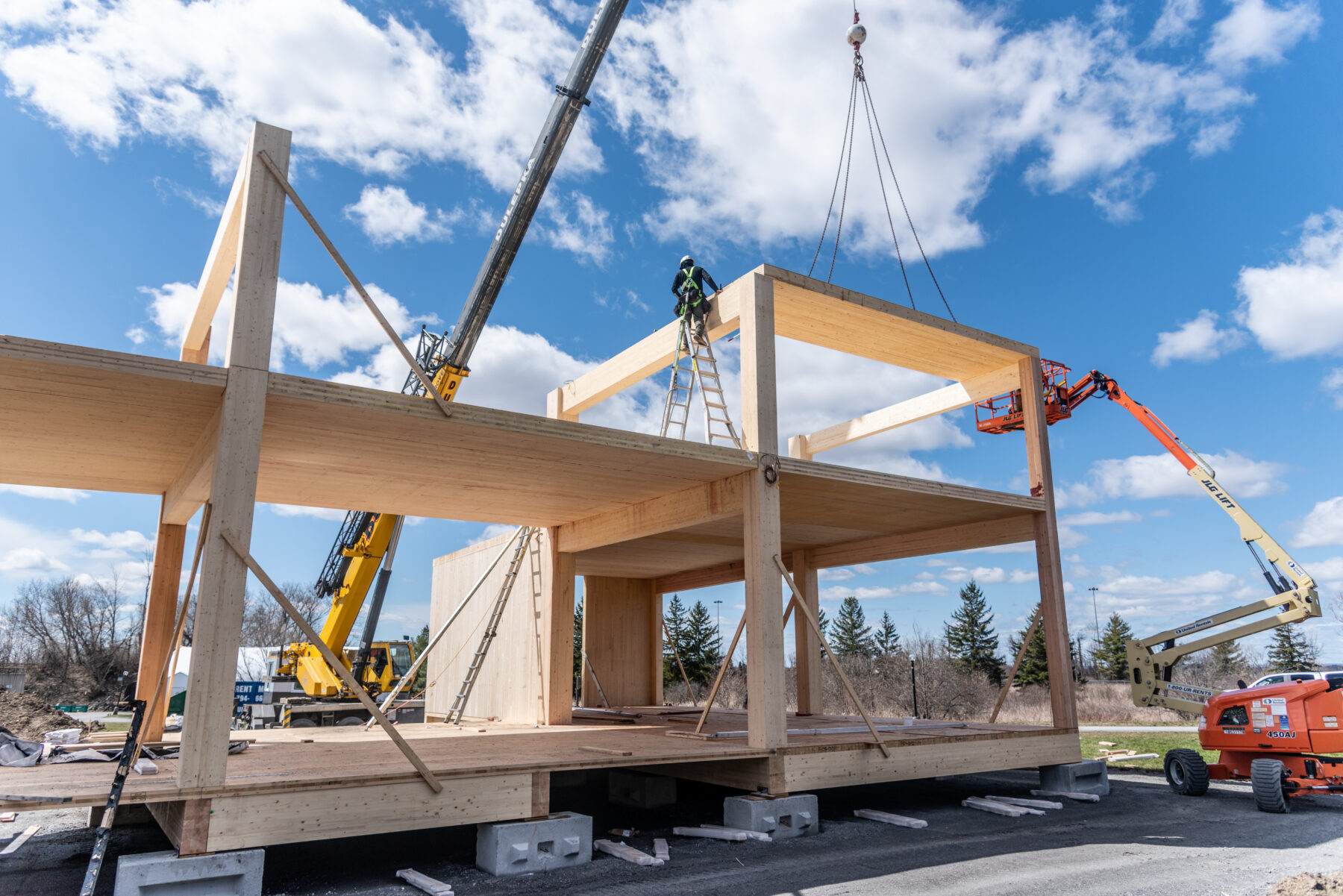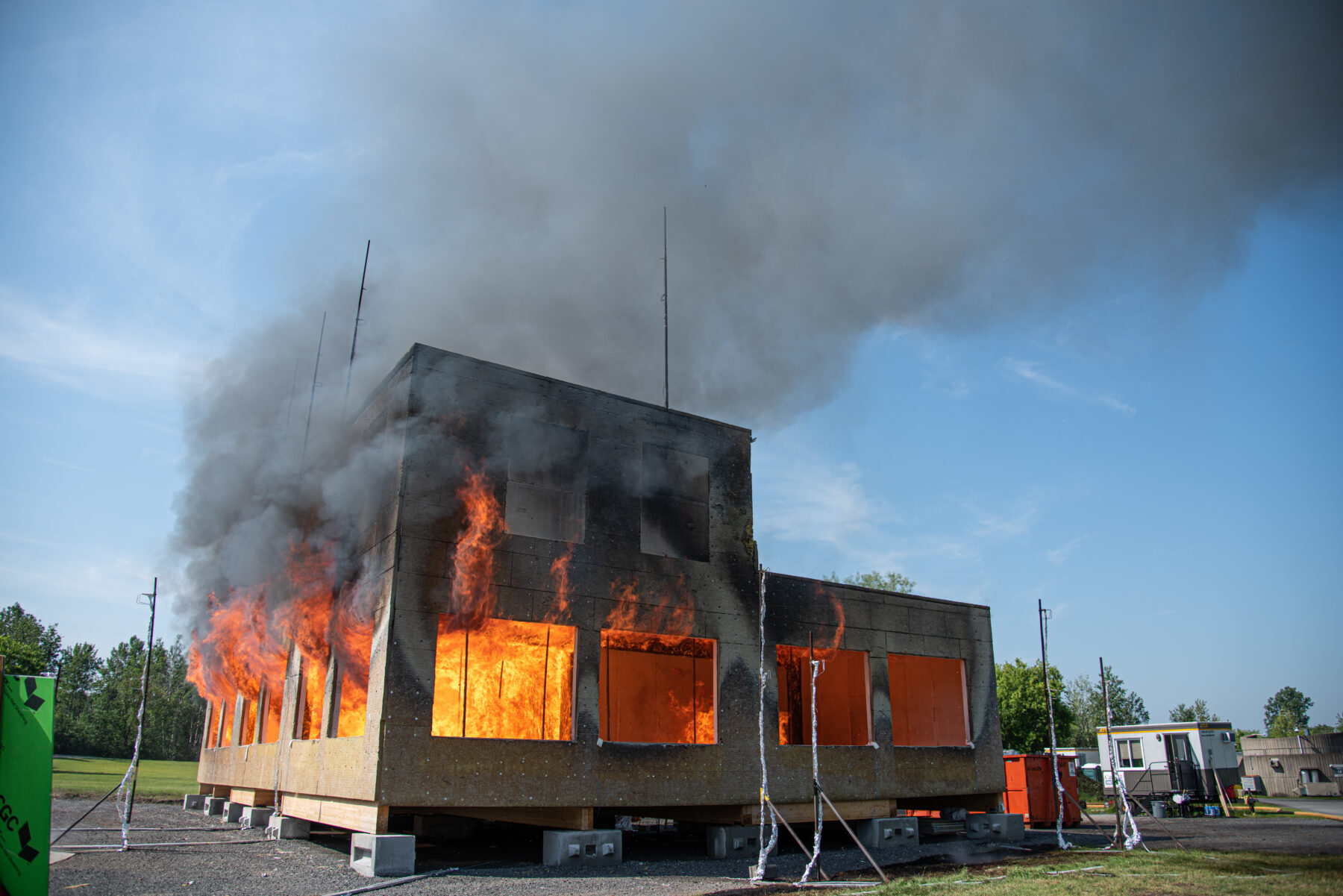Latest testing further documents mass timber’s fire safety
The Mass Timber Demonstration Fire Test Program investigated worst-case fire scenarios.

Developers and other project owners in pursuit of low-carbon construction methods are increasingly choosing mass timber for their projects. But to do so in larger and taller buildings, they must reassure civic leaders, fire and rescue services and insurance underwriters—along with the public—that these projects are fire safe.
New research, supported by the National Research Council of Canada (NRC), Canadian Wood Council and federal and provincial governments, is doing just that. A recent series of tests, dubbed the Mass Timber Demonstration Fire Test Program, show, even in worst-case fire scenarios, mass timber buildings perform similarly to noncombustible construction.
Sparking Questions: Are bigger and taller mass timber buildings fire safe?
The calls to construct more buildings with mass timber to help tackle climate change are growing. This is true here in B.C., across the country and around the world, demonstrated by the growing announcements of ever-taller wood buildings.
It’s not just the building industry touting mass timber’s benefits. In a recent report, Canada’s biggest bank points out that constructing taller wood buildings and swapping concrete and steel with mass timber represents a potential 12% to 25% drop in carbon emissions.
So far, Canada has successfully completed more than 660 mass timber projects, with B.C. and Quebec accounting for 257 and 184 projects, respectively. Ontario has at least 90 mass timber projects.
“In B.C., we do have a precedent of building taller wood buildings in several jurisdictions through an alternate solution process. Taller, more dense mass timber buildings can help play a greater role in addressing both climate and affordable housing challenges,” says Shawn Keyes, executive director of WoodWorks BC and professional engineer.
“But to open this market further, we need to support ongoing fire research, like this [Mass Timber Demonstration Fire Test Program] to reassure stakeholders and further document mass timber’s fire safety. This can help support the evolution of the building code at the national and provincial levels to allow for even taller mass timber buildings.”

Keyes points out this recent series of mass timber fire tests adds to a growing body of research proving that low-carbon, engineered wood products are fire safe. In the event of a fire, previous testing has shown mass timber products char on the outside, forming a protective layer for the unburned wood below the char layer, which retains structural strength.
For example, in a previous fire resistance test, when a mass timber panel (five-ply, cross-laminated timber) wall was subjected to extremely high temperatures in a standard fire scenario, its structural capacity withstood the exposure for over three hours—longer than building codes require. This was the case even when it was not encapsulated with a fire-resistive layer.
B.C. is a leader in mass timber, with legislation that incentivizes the use of wood in publicly funded buildings. The provincial building code permits the construction of six-storey wood-frame and mass timber residential buildings and some municipalities have adopted the 2020 National Building Code which permits the construction of 12-storey mass timber buildings.
These tests are worst-case fire scenarios designed to demonstrate how mass timber responds to severe fire conditions. Even in the extremely rare condition where sprinklers have failed and fire fighters are unable to reach the fire, the mass timber structure begins to put itself out once the building contents have burned away.
Marc Alam, Senior Manager, Codes and Standards for the Canadian Wood Council
Wood engineering and fire experts believe this latest round of fire tests provides strong evidence that the code can further evolve to allow for more exposed wood and taller mass timber buildings.
“This new series of fire testing shows that taller wood buildings, including those with exposed timber, do achieve fire safety standards and provide good fire performance, comparable to other building materials. They provide strong evidence to evolve the National Building Code,” explains Marc Alam, Senior Manager, Codes and Standards for the Canadian Wood Council.
Five fire tests: understanding the scenarios and the bottom-line results
The Mass Timber Demonstration Fire Test Program—using a two-storey, 334 square-metre (3,600 square-foot) mass timber structure—is the nation’s largest and most comprehensive mass timber fire test series to date. The bottom-line results, complemented by expert analysis, show that mass timber is safe, even in rare instances of serious, unattended fires.
“These tests are worst-case fire scenarios designed to demonstrate how mass timber responds to severe fire conditions. Even in the extremely rare condition where sprinklers have failed and fire fighters are unable to reach the fire, the mass timber structure begins to put itself out once the building contents have burned away,” says Alam.
“The bottom-line results and what these extreme tests show is, even under those rare conditions, the mass timber fire decays and begins to put itself out after ignition,” Alam adds.
Held in Ottawa in the summer of 2022, more than 150 experts from across Canada, including fire officials, building regulators, insurance industry representatives, engineers and architects, as well as wood industry and NRC fire research experts, witnessed the fire testing firsthand. Several national consulting firms provided expert analysis, while suppliers from across Canada provided the mass timber materials for the test structure.
“These tests are giving municipalities, code officials, fire service professionals and insurers a lot of good information—and it was really helpful that many of these folks were able to see the tests as they were conducted. It is becoming clearer through this research that mass timber buildings perform well and these buildings aren’t going to be any more difficult to put out a fire than a steel or a concrete building when built to best practice standards,” says Steven Craft, a fire engineering expert and founding principal at CHM Fire Consultants Ltd., one of the firms contributing to the fire test analysis and final report.
Here’s a summary of the five test scenarios:
Test # and Date: Test 1 (July 7, 2022)
Test Type: Completed residential suite: A code-prescribed solution for noncombustible construction
Location: 2nd storey residential Suite B
Description: The first test involved a fire in a fully furnished residential suite as a baseline scenario representing a National Building Code prescribed solution for noncombustible construction permitted for a tall building. The test provides a baseline scenario for comparison purposes, representing an acceptable solution of the National Building Code (e.g., a code-prescribed solution) permitted for a high building of noncombustible construction. Three of the four interior walls were finished with plywood. The ceiling was finished with fire-retardant-treated plywood. The floor and all structural elements are protected and did not contribute to the fire.
Test # and Date: Test 2 (July 14, 2022)
Test Type: Completed residential suite: Exposed mass timber
Location: 2nd storey residential Suite A
Description: The second test shows the performance of exposed mass timber in a realistic occupied residential scenario for direct comparison with Test 1, the code-prescribed solution for noncombustible construction. The side-by-side comparison of an identical space with identical fuel load and ventilation conditions in Test 1 gives a performance comparison between a fire compartment in a building of non-combustible construction and one with exposed mass timber construction.
Test # and Date: Test 3 (Sept. 29, 2022)
Test Type: Construction site: Garbage bin fire source
Location: 2nd storey residential Suite B
Description: The third test shows the performance of exposed mass timber during a construction site fire (severe garbage can fire). In this scenario the floor, ceiling and one wall are exposed mass timber. Other compartment walls are protected with gypsum.
Test # and Date: Test 4 (Sept. 15, 2022)
Test Type: Construction site: Exposed mass timber
Location: 2nd storey residential Suite C
Description: The fourth test shows the performance of exposed mass timber in a realistic but severe construction site scenario. The fuel load included wood cribs in addition to light wood framing installed in a typical residential suite configuration that had not yet been protected by gypsum board.
Test # and Date: Test 5 (June 22, 2022)
Test Type: Completed building: Open plan office floor with exposed mass timber
Location: Full 1st storey
Description: The fifth test shows fire performance and dynamics in a typical occupied open-office space in a mass timber building. The space is much larger than previous tests with a larger footprint as well as a higher floor to ceiling height.
Common findings in all five tests
Craft points to some common and promising findings across all five fire scenarios, which are further elaborated on in the technical report.
In all five tests, the test mass timber structure remained stable and solid enduring the cumulative effects of five severe fire tests with a total fire exposure of 19 hours, and the stair shaft was not adversely affected in any test.
While some exposed CLT ceilings showed some delamination in the cooling period, this did not cause any re-ignition or fire regrowth.
The average char depths in the exposed mass timber members were well within the two-hour fire-resistance rating in all the tests.
What do these results mean for mass timber construction?
Although there isn’t a quick and simple solution when it comes to fire testing and safety, these test results are giving us additional and valuable data points. According to Craft, these data sets complement previous testing that has shown mass timber buildings can be built to provide good fire safety.
“Through all the [mass timber] fire research that we’ve done to date, and over the last 15 years, I believe the building industry and fire experts have gained a really good appreciation for how we can design mass timber buildings to be safe and fire resistant. These tests are showing how we can go taller and expose more wood in these buildings while staying fire safe,” adds Craft.
These latest tests go further to specifically show how open plan workplaces with exposed mass timber—an increasingly popular trend in office design—are fire safe.
“In the open office floor plan scenario, the test shows the fire quickly died down on its own. Once all the fuel load was used up—basically the furnishings—the fire decays. As follow-ups to past tests with smaller compartments, this new research shows we get as good or better performance in an open office scenario,” Craft points out.
Similar to past mass timber fire tests, Craft adds, these tests reinforce how mass timber performs differently than light-frame wood construction. Mass timber’s inherent natural resistance to fire, paired with good fire design, makes the fire performance of mass timber buildings comparable to noncombustible steel and concrete buildings.
What do these results mean for building codes and insurers?
To build taller than 12 storeys with mass timber—outside of an alternative solution process—requires a change in the building code at the national and provincial levels. These recent fire test results open the possibility to both.
“These robust mass timber fire tests give developers and design teams good, solid justification to go above what the code requires and use these test results as part of their alternative means submission,” explains Alam.
Eventually, Craft, Alam, and Keyes see these tests helping to evolve the national, and subsequent provincial codes, beyond the current height and encapsulation restrictions.
The results can also offer more reassurances to underwriters, and help them better understand mass timber’s fire performance properties to potentially lower the cost associated with insuring mass timber buildings.
Insurance underwriting has emerged as the most difficult challenge for both mass timber building construction and occupancy insurance, according to the recent Royal Bank report. For the most part, mass timber buildings require a customized policy, which adds to a project’s final cost, and is ultimately passed down to the owner or end buyer.
“I believe there is an increasing body of insurers who are becoming more accepting and understanding of the differences in mass timber fire behaviour, particularly how it differs from light-frame wood construction. Our hope is that this type of testing can begin to answer their questions and eventually help standardize premiums and bring down insurance costs,” says Keyes.
In many respects, B.C. is leading when it comes to mass timber construction. After bringing to market Brock Commons, the first 18-storey timber hybrid building in the world, the province has seen rapid growth in the number of taller mass timber buildings constructed, he points out.
“I anticipate the Province, and the broader industry, will benefit from this comprehensive fire testing as the results are used to streamline building codes, expanding the use of wood to help tackle climate change and boost the construction of more sustainable, affordable housing.”
To view and download the full technical report click here.

